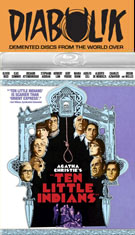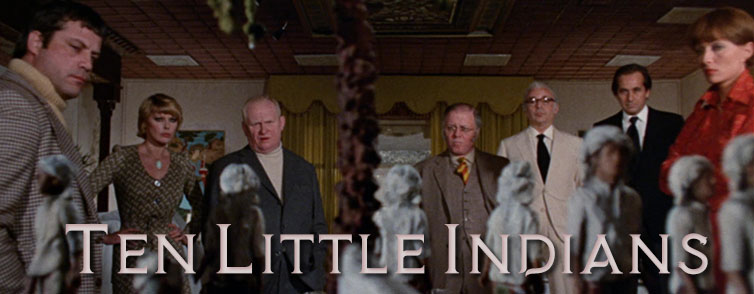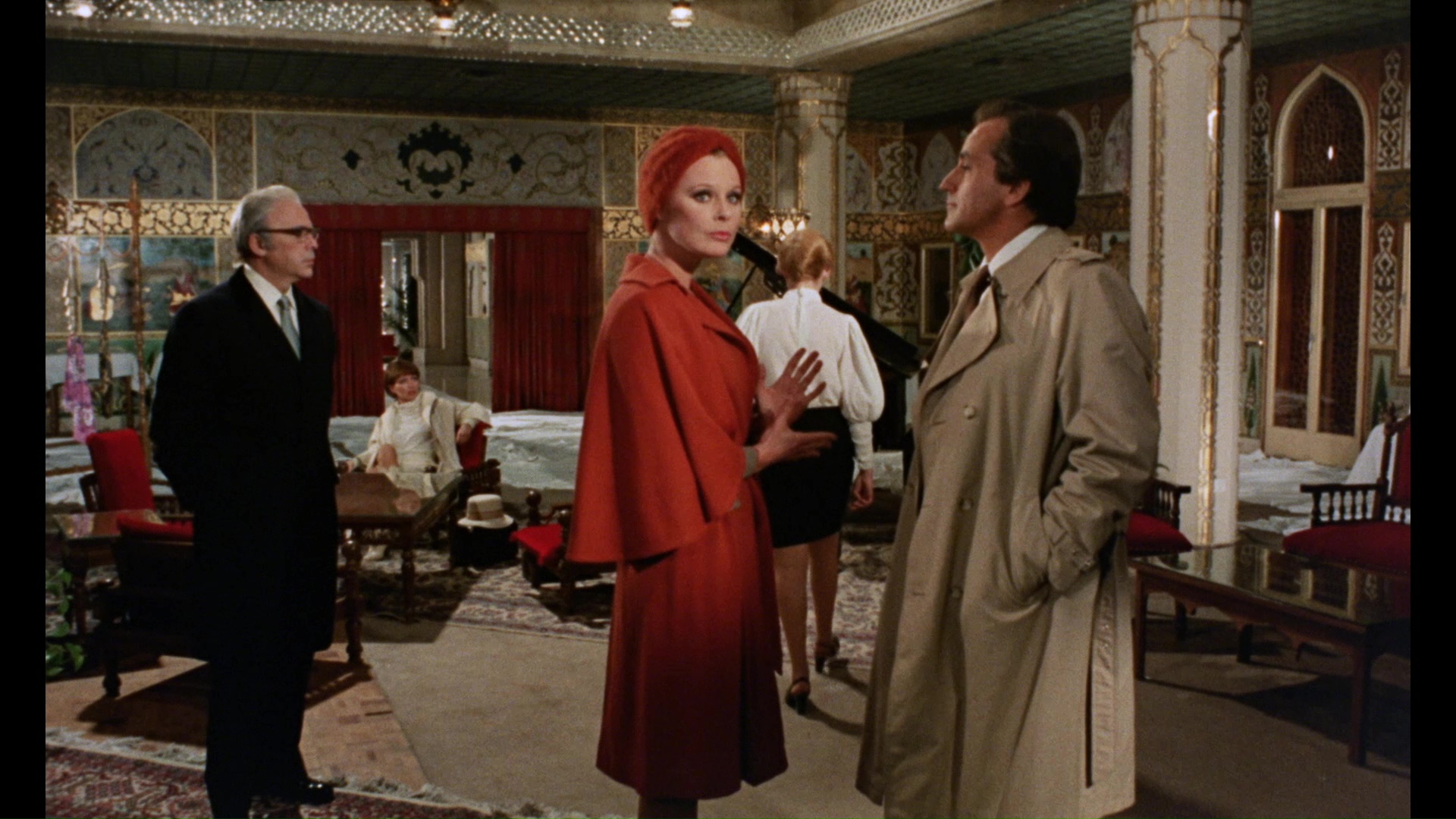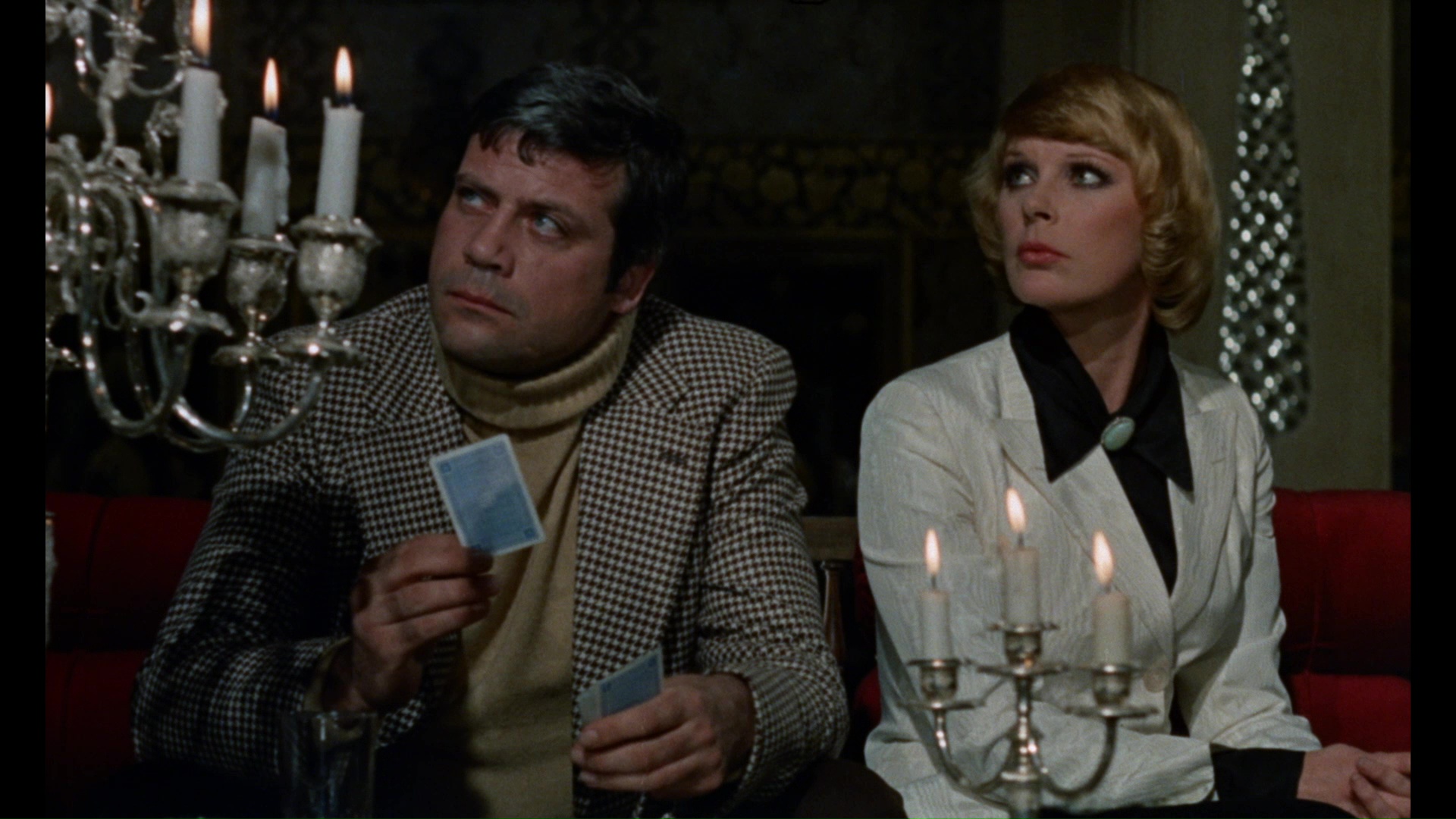

Color, 1974, 98 mins. 8 secs.
Directed by Peter Collinson
Starring Oliver Reed, Elke Sommer, Richard Attenborough, Herbert Lom, Gert Fröbe, Stephane Audran, Maria Rohm, Charles Aznavour, Adolfo Celi, Alberto de Mendoza
Scorpion Releasing (Blu-ray & DVD) (US RA/R1 HD/NTSC), Divisa (Blu-ray & DVD) (Spain RB/R2 HD/PAL), Studio Canal (DVD) (UK R2 PAL), Divisa (Blu-ray & DVD) (Spain R0 HD/PAL), Filmjuwelen (DVD) (Germany R2 PAL), Future Film (DVD) (Scandinavia R2 PAL) / WS (1.66:1) (16:9)


When word got out that Sidney Lumet was mounting the screen's first adaptation of Agatha Christie's Murder on the Orient Express as a lavish, all-star event film for 1974, the news was particularly welcome for producer Harry Allan Towers, the international deal maker who had recently completed a cycle of films with Jess Franco like Eugenie, 99 Women, and Venus in Furs. Towers still retained the rights to Christie's highest-selling novel, Ten Little Indians (also published as And Then There Were None and, uh, a different original title in the U.K.), after mounting his first version in 1965 with Hugh O'Brian and Shirley Eaton. In fact, that had been the second English-language version of the Christie novel, following the classic 1945 version by René Clair, so Towers had a lot to live up to with his own '74 edition. That project was put together quickly (with Towers' wife and frequent Franco star Maria Rohm in the cast) and shot with the script for the '65 version left intact almost word for word apart from switching the location from a snowy Swiss mountain chalet to an isolated, ornate hotel in the middle of the Iranian desert.
The Towers film ended up barely beating Lumet's to theaters in several territories including most European countries (though not the U.S.), but that turned out to be a bad idea as critics had their knives sharpened for what was perceived as a trashy Euro-pudding cash-in with a crazy assortment of stars including two James Bond villains, a popular French crooner, and other assorted concessions to the numerous countries that had invested in the project. Like the previous two films this essentially follows the storyline  of Christie's stage adaptation from the
of Christie's stage adaptation from the  book rather than novel itself (which has a far bleaker ending), but the execution by director Peter Collinson (The Italian Job, Fright) is much darker than its predecessors in both look and atmosphere. This was the first version of the tale in color, and Collinson bathes the film with heavy reds and browns against the exotic backdrop of the hotel itself (which is just as much a character in its own right). The alternately elegant and pounding score by the great Bruno Nicolai (which features echoes of his stellar work on A Virgin among the Living Dead) and the more intense murder scenes betray a strong giallo influence here, particularly a nocturnal outdoor bit with Rohm and an Argento-esque underground stabbing scene, so this will likely be received far more by fans of Euro horror than the usual Christie fans. It's certainly more interesting and atmosphericthan initial impressions from critics and viewers might have given, and time has been kind to its blend of art house and exploitation casting and execution.
book rather than novel itself (which has a far bleaker ending), but the execution by director Peter Collinson (The Italian Job, Fright) is much darker than its predecessors in both look and atmosphere. This was the first version of the tale in color, and Collinson bathes the film with heavy reds and browns against the exotic backdrop of the hotel itself (which is just as much a character in its own right). The alternately elegant and pounding score by the great Bruno Nicolai (which features echoes of his stellar work on A Virgin among the Living Dead) and the more intense murder scenes betray a strong giallo influence here, particularly a nocturnal outdoor bit with Rohm and an Argento-esque underground stabbing scene, so this will likely be received far more by fans of Euro horror than the usual Christie fans. It's certainly more interesting and atmosphericthan initial impressions from critics and viewers might have given, and time has been kind to its blend of art house and exploitation casting and execution.
In case you aren't familiar with the story, this is basically the original body count narrative as ten strangers are invited to a weekend at an exclusive hotel. At dinner on the first night, a mysterious voice (here played by an unseen Orson Welles) accuses them all of murders for which they were never convicted, which sets off a string of increasingly violent deaths among the attendees including singer and bad driver Michel (Aznavour), jittery secretary Vera (Lisa and the Devil's Sommer), strong-jawed Hugh (Reed), sardonic Judge Cannon (Attenborough), shifty Dr. Armstrong (Lom), mysterious globetrotter Ilona (Claude Chabrol wife and  muse Audran), hardened military commander General Salve (Thunderball's Celi), beautiful Elsa (Rohm), blustering Blore (Goldfinger's Fröbe) and swarthy Otto (Horror Express' de Mendoza). The murder pattern appears to be modeled after a familiar nursery rhyme about ten little Indian boys, all of whom meet a nasty end until none are left. Will these unfortunate guests meet the same fate?
muse Audran), hardened military commander General Salve (Thunderball's Celi), beautiful Elsa (Rohm), blustering Blore (Goldfinger's Fröbe) and swarthy Otto (Horror Express' de Mendoza). The murder pattern appears to be modeled after a familiar nursery rhyme about ten little Indian boys, all of whom meet a nasty end until none are left. Will these unfortunate guests meet the same fate?
Despite his early successes, director Collinson was less than a critical favorite at this point after a string of violent films like  Open Season, The Man Called Noon, and Innocent Bystanders. That streak continued here, and like the rest of his films from this period, it's a misanthropic but fascinating film with a dynamic visual style that uses the shadowy depths of the hotel to striking effect. That aspect wasn't always easy to appreciate in the rather muddy American prints circulated by Avco Embassy, but since then it's become more obvious that the film as quite a bit to offer beyond its wild casting choices. The film also earned a more positive reputation when Towers returned to the well a third time for a Cannon Films version in 1989, which brought Lom back (in a different role) and shifted the location to an African safari, with Frank Stallone, Brenda Vaccaro, and Donald Pleasence along for the ride. Shortly before that, a 1987 Russian version made history as the first to use Christie's original book ending, which has only been used since in the very downbeat, two-part 2015 BBC miniseries (which also scrubs away any "politically incorrect" ethnic associations with the nursery rhyme).
Open Season, The Man Called Noon, and Innocent Bystanders. That streak continued here, and like the rest of his films from this period, it's a misanthropic but fascinating film with a dynamic visual style that uses the shadowy depths of the hotel to striking effect. That aspect wasn't always easy to appreciate in the rather muddy American prints circulated by Avco Embassy, but since then it's become more obvious that the film as quite a bit to offer beyond its wild casting choices. The film also earned a more positive reputation when Towers returned to the well a third time for a Cannon Films version in 1989, which brought Lom back (in a different role) and shifted the location to an African safari, with Frank Stallone, Brenda Vaccaro, and Donald Pleasence along for the ride. Shortly before that, a 1987 Russian version made history as the first to use Christie's original book ending, which has only been used since in the very downbeat, two-part 2015 BBC miniseries (which also scrubs away any "politically incorrect" ethnic associations with the nursery rhyme).
For some reason, this film was very difficult to see in the United States for decades after its initial VHS release. Eventually it made its DVD debut in 2010 from Studio Canal in the UK as And Then There Were None, featuring a very attractive, remastered 1.66:1 transfer that looks much more satisfying than the claustrophobic 1.85:1 framing seen in many theaters. The same transfer was recycled for a handful of other European DVD releases afterwards. Ten Little Indians finally turned up in America again in 2017 from Scorpion Releasing on Blu-ray,  sourced from an
sourced from an  organic,apparently untouched HD scan from the film's Italian licensor. Film grain and occasional specks have been left completely untouched here, which is actually pretty good news as it means that depth and clarity don't suffer at all given the moody, sometimes filtered way the film was shot, and the original elements have been kept in good shape over the years. The plentiful wide shots of the hotel lobby with actors studded around in various compositions are especially evocative and make this an ideal way to approach the film either for the first time or a return visit. The DTS-HD MA 2.0 English mono track also sounds very healthy and does justice to Nicolai's score. Extras include a new audio commentary with yours truly and Howard S. Berger, which obviously can't be appraised here but will hopefully be of value to listeners, the Italian credits (as ...E Poi, Non Ne Remiase Nessuno, or "And Then There Were None"), the international English theatrical trailer as And Then There Were None (which even plays like a giallo), a very lo-res '80s VHS promo, and bonus trailers for City on Fire, Barbarosa, Saint Jack, Steaming, and Killer Force. The Spanish release from Divisa (also a 2017 Blu-ray release, with watchable but rougher video quality) is an interesting oddity as it represents an alternate cut prepared for some territories (108m26s) notable for a long prologue with the characters arriving at an airport and some various arrangements going on with cars and a helicopter boaring. This sequence (presented only in Spanish, though the rest of the film can be played in English) is totally disposable but at least makes sense of Rik Battaglia's name in the credits; oddly, the end of the film is actually cut shorter and concludes very abruptly.
organic,apparently untouched HD scan from the film's Italian licensor. Film grain and occasional specks have been left completely untouched here, which is actually pretty good news as it means that depth and clarity don't suffer at all given the moody, sometimes filtered way the film was shot, and the original elements have been kept in good shape over the years. The plentiful wide shots of the hotel lobby with actors studded around in various compositions are especially evocative and make this an ideal way to approach the film either for the first time or a return visit. The DTS-HD MA 2.0 English mono track also sounds very healthy and does justice to Nicolai's score. Extras include a new audio commentary with yours truly and Howard S. Berger, which obviously can't be appraised here but will hopefully be of value to listeners, the Italian credits (as ...E Poi, Non Ne Remiase Nessuno, or "And Then There Were None"), the international English theatrical trailer as And Then There Were None (which even plays like a giallo), a very lo-res '80s VHS promo, and bonus trailers for City on Fire, Barbarosa, Saint Jack, Steaming, and Killer Force. The Spanish release from Divisa (also a 2017 Blu-ray release, with watchable but rougher video quality) is an interesting oddity as it represents an alternate cut prepared for some territories (108m26s) notable for a long prologue with the characters arriving at an airport and some various arrangements going on with cars and a helicopter boaring. This sequence (presented only in Spanish, though the rest of the film can be played in English) is totally disposable but at least makes sense of Rik Battaglia's name in the credits; oddly, the end of the film is actually cut shorter and concludes very abruptly.
Reviewed on June 15, 2017.





 of Christie's stage adaptation from the
of Christie's stage adaptation from the  book rather than novel itself (which has a far bleaker ending), but the execution by director Peter Collinson (The Italian Job, Fright) is much darker than its predecessors in both look and atmosphere. This was the first version of the tale in color, and Collinson bathes the film with heavy reds and browns against the exotic backdrop of the hotel itself (which is just as much a character in its own right). The alternately elegant and pounding score by the great Bruno Nicolai (which features echoes of his stellar work on A Virgin among the Living Dead) and the more intense murder scenes betray a strong giallo influence here, particularly a nocturnal outdoor bit with Rohm and an Argento-esque underground stabbing scene, so this will likely be received far more by fans of Euro horror than the usual Christie fans. It's certainly more interesting and atmosphericthan initial impressions from critics and viewers might have given, and time has been kind to its blend of art house and exploitation casting and execution.
book rather than novel itself (which has a far bleaker ending), but the execution by director Peter Collinson (The Italian Job, Fright) is much darker than its predecessors in both look and atmosphere. This was the first version of the tale in color, and Collinson bathes the film with heavy reds and browns against the exotic backdrop of the hotel itself (which is just as much a character in its own right). The alternately elegant and pounding score by the great Bruno Nicolai (which features echoes of his stellar work on A Virgin among the Living Dead) and the more intense murder scenes betray a strong giallo influence here, particularly a nocturnal outdoor bit with Rohm and an Argento-esque underground stabbing scene, so this will likely be received far more by fans of Euro horror than the usual Christie fans. It's certainly more interesting and atmosphericthan initial impressions from critics and viewers might have given, and time has been kind to its blend of art house and exploitation casting and execution.  muse Audran), hardened military commander General Salve (Thunderball's Celi), beautiful Elsa (Rohm), blustering Blore (Goldfinger's Fröbe) and swarthy Otto (Horror Express' de Mendoza). The murder pattern appears to be modeled after a familiar nursery rhyme about ten little Indian boys, all of whom meet a nasty end until none are left. Will these unfortunate guests meet the same fate?
muse Audran), hardened military commander General Salve (Thunderball's Celi), beautiful Elsa (Rohm), blustering Blore (Goldfinger's Fröbe) and swarthy Otto (Horror Express' de Mendoza). The murder pattern appears to be modeled after a familiar nursery rhyme about ten little Indian boys, all of whom meet a nasty end until none are left. Will these unfortunate guests meet the same fate?  Open Season, The Man Called Noon, and Innocent Bystanders. That streak continued here, and like the rest of his films from this period, it's a misanthropic but fascinating film with a dynamic visual style that uses the shadowy depths of the hotel to striking effect. That aspect wasn't always easy to appreciate in the rather muddy American prints circulated by Avco Embassy, but since then it's become more obvious that the film as quite a bit to offer beyond its wild casting choices. The film also earned a more positive reputation when Towers returned to the well a third time for a Cannon Films version in 1989, which brought Lom back (in a different role) and shifted the location to an African safari, with Frank Stallone, Brenda Vaccaro, and Donald Pleasence along for the ride. Shortly before that, a 1987 Russian version made history as the first to use Christie's original book ending, which has only been used since in the very downbeat, two-part 2015 BBC miniseries (which also scrubs away any "politically incorrect" ethnic associations with the nursery rhyme).
Open Season, The Man Called Noon, and Innocent Bystanders. That streak continued here, and like the rest of his films from this period, it's a misanthropic but fascinating film with a dynamic visual style that uses the shadowy depths of the hotel to striking effect. That aspect wasn't always easy to appreciate in the rather muddy American prints circulated by Avco Embassy, but since then it's become more obvious that the film as quite a bit to offer beyond its wild casting choices. The film also earned a more positive reputation when Towers returned to the well a third time for a Cannon Films version in 1989, which brought Lom back (in a different role) and shifted the location to an African safari, with Frank Stallone, Brenda Vaccaro, and Donald Pleasence along for the ride. Shortly before that, a 1987 Russian version made history as the first to use Christie's original book ending, which has only been used since in the very downbeat, two-part 2015 BBC miniseries (which also scrubs away any "politically incorrect" ethnic associations with the nursery rhyme).  sourced from an
sourced from an  organic,apparently untouched HD scan from the film's Italian licensor. Film grain and occasional specks have been left completely untouched here, which is actually pretty good news as it means that depth and clarity don't suffer at all given the moody, sometimes filtered way the film was shot, and the original elements have been kept in good shape over the years. The plentiful wide shots of the hotel lobby with actors studded around in various compositions are especially evocative and make this an ideal way to approach the film either for the first time or a return visit. The DTS-HD MA 2.0 English mono track also sounds very healthy and does justice to Nicolai's score. Extras include a new audio commentary with yours truly and Howard S. Berger, which obviously can't be appraised here but will hopefully be of value to listeners, the Italian credits (as ...E Poi, Non Ne Remiase Nessuno, or "And Then There Were None"), the international English theatrical trailer as And Then There Were None (which even plays like a giallo), a very lo-res '80s VHS promo, and bonus trailers for City on Fire, Barbarosa, Saint Jack, Steaming, and Killer Force. The Spanish release from Divisa (also a 2017 Blu-ray release, with watchable but rougher video quality) is an interesting oddity as it represents an alternate cut prepared for some territories (108m26s) notable for a long prologue with the characters arriving at an airport and some various arrangements going on with cars and a helicopter boaring. This sequence (presented only in Spanish, though the rest of the film can be played in English) is totally disposable but at least makes sense of Rik Battaglia's name in the credits; oddly, the end of the film is actually cut shorter and concludes very abruptly.
organic,apparently untouched HD scan from the film's Italian licensor. Film grain and occasional specks have been left completely untouched here, which is actually pretty good news as it means that depth and clarity don't suffer at all given the moody, sometimes filtered way the film was shot, and the original elements have been kept in good shape over the years. The plentiful wide shots of the hotel lobby with actors studded around in various compositions are especially evocative and make this an ideal way to approach the film either for the first time or a return visit. The DTS-HD MA 2.0 English mono track also sounds very healthy and does justice to Nicolai's score. Extras include a new audio commentary with yours truly and Howard S. Berger, which obviously can't be appraised here but will hopefully be of value to listeners, the Italian credits (as ...E Poi, Non Ne Remiase Nessuno, or "And Then There Were None"), the international English theatrical trailer as And Then There Were None (which even plays like a giallo), a very lo-res '80s VHS promo, and bonus trailers for City on Fire, Barbarosa, Saint Jack, Steaming, and Killer Force. The Spanish release from Divisa (also a 2017 Blu-ray release, with watchable but rougher video quality) is an interesting oddity as it represents an alternate cut prepared for some territories (108m26s) notable for a long prologue with the characters arriving at an airport and some various arrangements going on with cars and a helicopter boaring. This sequence (presented only in Spanish, though the rest of the film can be played in English) is totally disposable but at least makes sense of Rik Battaglia's name in the credits; oddly, the end of the film is actually cut shorter and concludes very abruptly.